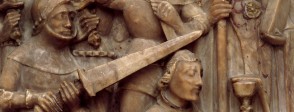Here are two ideas for activities encouraging close observation of the object to support its interpretation.
Show an image of the alabaster panel showing Becket’s murder in For the classroom. Ask your students to look closely and to say what they think is happening in the picture. Who might the characters be, and how can they tell? Where might the action be taking place, and how do they know this? if you are just starting the topic ask what other information they would want to find out in order to understand the image. The British Museum mini-lesson on reliquaries and pilgrimage can support you here with specific questions.
Before telling your students what is happening in the scene, divide them into groups and provide each with the three other images depicting Becket’s martyrdom – see For the classroom and the two caskets in A bigger picture. Ask each group to find similarities and differences between the images. Do they still think the characters, setting and action are the same as on the alabaster? Ask them to look closely at each object, including the alabaster: what materials are they made from, can they suggest where they might have been seen?
These activities explore the background to the death of Thomas Becket.
Play the Class Clip about the death of Thomas Becket in For the classroom. Now ask your students to look at the alabaster and see if they are able to identify the different characters, and where it is taking place. Can they spot the narrator of the clip on the alabaster? What are their impressions of Becket? What motivations do they think the knights had for killing him? How would they justify the killing if questioned?
Show the Class Clip about Henry II and Becketin in For the classroom. Using the video and the timeline of events, ask each student to create their own news report of the events. This could be video-recorded in groups or used to create a newspaper article. The students will need to think about who their audience is, what the key facts are, and what the most interesting information is. This can lead into a discussion about what really happened: do they think that Becket or Henry was right? Why do they think this? What other information might they need to make an informed decision? The BBC overview of events can also support here, especially the section on interpretations of the events.
These activities look at the religious and political messages of alabaster altarpieces.
Ask your students what material they think the panel of Becket’s murder was made from. Then ask them where they think a carving like this would have been displayed. Show them the picture of the Swansea altarpiece in For the classroom and explain that the Becket alabaster was probably displayed alongside others in an altarpiece – look at examples of where altarpieces were located using images in the internet. What impression would the altarpiece have made? Why might a church choose to commission an altarpiece showing such scenes? What do they think may have made up other scenes on the altarpiece from which the Becket alabaster comes? Look at other examples of alabasters showing events from Becket’s life – see For the classroom.
Build up an overview of the life of Thomas Becket using the Class Clip and timeline and supplement these if necessary. Divide the students into two sets of smaller groups. One set of groups are archbishops in mainland Europe who want to commission an altarpiece about Becket; the other are English archbishops. Brief each set secretly: the Europeans want an altarpiece that emphasises Becket as a martyr of the church against the state; the English want to emphasise the goodness and piety of Thomas. Ask the groups to select five events in Becket’s life for their particular altarpiece. Compare the results.
Use the British Museum mini-lesson in For the classroom to introduce the concept of relics and pilgrimage. There are activities within the mini-lesson. Use images from A bigger picture and ask your students to compare the objects and to discuss what each one was used for. Was it a souvenir or a reliquary? How different or similar are the designs? How can they tell that these were part of the cult of Becket? Who might have owned each object? What does this tell you about the nature of the cult of Becket?
What can the popularity of Becket’s cult tell us about the lives of people in medieval England?
Start the enquiry by looking at lots of examples of objects showing the death of Becket and identifying who they may have belonged to and where they may have been seen – select objects that cover a range of social classes and also find examples of French stained glass using the internet. Read the first 30 lines of the Canterbury Tales to identify Canterbury and Becket’s shrine as a pilgrimage site and a place of healing. Tell pupils that they can only make sense of this phenomenon after they have studied the world in which was made. Follow a sequence of learning that covers religion, social diversity and medieval health in such a way that the proliferation of Becket objects should make sense to them by the end. They should round off their learning by preparing presentations based on the original alabaster.


